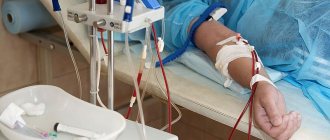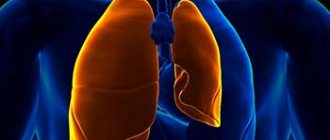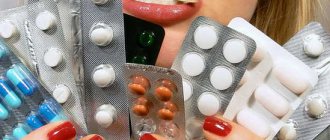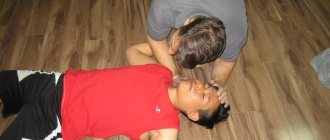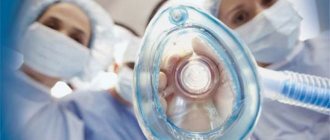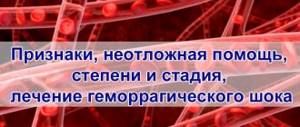Pre-medical first aid - algorithm of actions for anaphylactic shock
- Lay the patient on a flat surface, raise his legs (for example, place a blanket rolled up under them);
- Turn your head to one side to prevent aspiration of vomit, remove dentures from your mouth;
- Provide a flow of fresh air into the room (open a window, door);
- Take measures to stop the entry of the allergen into the victim’s body - remove the sting with poison, apply an ice pack to the bite or injection site, apply a pressure bandage above the bite site, and so on.
- Feel the patient's pulse: first on the wrist, if it is absent, then on the carotid or femoral arteries. If there is no pulse, begin performing indirect cardiac massage - clasp your hands and place them on the middle part of the sternum, apply rhythmic points 4-5 cm deep;
- Check if the patient is breathing: see if there are movements of the chest, apply a mirror to the patient’s mouth. If there is no breathing, it is recommended to begin artificial respiration by inhaling air into the patient’s mouth or nose through a napkin or handkerchief;
- Call an ambulance or transport the patient yourself to the nearest hospital.
Symptoms of anaphylactic shock in children
Anaphylactic shock is especially dangerous in childhood due to insufficient development of organs and systems. Due to anatomical and physiological characteristics, this reaction in a child can develop very quickly. Most often, anaphylactic shock is the result of the introduction of a vaccine or any product into a child’s body.
Symptoms of anaphylactic shock in children: fear, anxiety, headache, skin rashes, sore throat, tachycardia, abdominal pain (not always). The speed at which the reaction occurs depends on how the allergen enters the body. When administered intravenously, an anaphylactic reaction occurs instantly. When eating - for several hours. Since it is impossible to predict the development of anaphylaxis, doctors recommend always having antiallergic drugs in your home medicine cabinet. Your doctor will advise you in more detail about the standards and recommendations for the composition of the first aid kit.
Important: if there is the slightest suspicion of the development of anaphylactic shock, you must immediately call an ambulance and give the baby an antihistamine tablet.
First aid for burns
Burns are: thermal - caused by fire, steam, hot objects and substances; chemical - acids and alkalis; electrical – by exposure to electric current or electric arc.
Thermal burns. If the victim's clothing catches fire, you need to quickly throw a coat or any thick fabric over him to stop the access of air, and extinguish the flame or knock out the flame with water. You should not run in burning clothes, as this will intensify the fire and increase the burn.
Clothes from the burned area are not torn off, but cut and carefully removed
There are four degrees of burns. With a first-degree burn, redness, swelling and sharp pain appear on the skin. With a second-degree burn, blisters form. A third degree burn is characterized by death of the deeper layers of the skin. In the fourth degree, tissue charring occurs.
The area of the burn can be determined by comparing it to the area of the palm, which is about 1% of the surface area of the human body. If the burn area exceeds 10–15% of the body surface, burn disease develops.
Its first manifestation is
burn shock.
The victims rush about in pain, try to run away, and are poorly oriented in their location and surroundings. Then excitement gives way to depression.
Helping with burns is responsible and difficult. First of all, it is necessary to eliminate exposure to high temperature. In case of a burn from boiling water, food, or resin, you must quickly remove clothing soaked in hot liquid.
You should not tear off the stuck clothing, but carefully trim the tissue around the wound with scissors, leaving the stuck areas. You should also try to remove burning clothing. You can lie on the ground, pressing the burning areas to it, you can cover the victim with a blanket or other dense fabric and the flame will die out due to the cessation of air supply
If there is a body of water or containers with water, it is necessary to immerse the affected area or part of the body in water. You cannot run in clothes that are on fire, or put out the flames with unprotected hands.
After extinguishing the clothes, you need to remove or remove the burned person from the fire zone. For several minutes, it is useful to irrigate the burn area with a stream of cold water or apply cold objects to it. This prevents further exposure to heat and reduces pain. Then a sterile bandage (individual dressing bag, sterile napkins) must be applied to the burn surface. If the latter are not available, you can use a clean cloth (sheet, towel, underwear). The material applied to the burn surface can be moistened with vodka or diluted alcohol, which anesthetizes and disinfects the burn site.
When providing assistance to a victim, in order to avoid infection, do not touch the burned areas of the skin with your hands or lubricate them with ointments, fats, oils, petroleum jelly, sprinkle them with baking soda, starch, etc. You cannot open blisters or remove mastic, rosin or other resinous substances that have stuck to the burned area, since by removing them you can easily tear off the burned skin and thereby create favorable conditions for the wound to become infected.
For small area burns of the first and second degrees, you need to lubricate the burned surface with alcohol and apply a sterile bandage to the burned area of skin.
Victims with third and fourth degree burns are given an aseptic bandage and taken to the hospital.
In case of severe and extensive burns, the victim must be wrapped in a clean sheet or cloth without undressing him, covered warmly, given warm tea and kept calm until the doctor arrives.
The burned face must be covered with sterile gauze.
In case of eye burns, cold lotions should be made from a solution of boric acid (half a teaspoon of acid per glass of water) and the victim should be immediately referred to a doctor.
Phosphorus burns
cause deep damage due to the fact that phosphorus easily dissolves in fats, therefore it penetrates deeply into the tissues, causing, in addition to signs of a burn (redness, swelling, tissue necrosis), signs of general poisoning of the body.
If phosphorus gets in, immediate neutralization of phosphorus on the affected areas with a 5% solution of copper sulfate (copper sulfate) is required, then application of napkins moistened with the same solution. Ointment dressings should not be applied to wounds.
The mechanism of development of the shock state and its causes
Burn shock develops with extensive superficial skin lesions (from 10 to 20% of the total body surface area). In this case, a state of shock can occur even with a small burnt area. The main thing in this matter is the depth of the burn lesion.
Symptomatic manifestations are similar to those of traumatic shock, but have some features that are important to consider during the treatment period. Let's consider the mechanism by which a dangerous condition develops
Let's consider the mechanism by which a dangerous condition develops.
The human body is a well-coordinated “computer system”. She, sensing danger, instantly rearranges her work to protect her main “components”: heart, brain, lungs and liver. The body urgently increases the volume of circulating blood entering these organs, rearranging the direction of systemic blood flow to the “central” channel.
Since the main blood flow is directed towards the “main” organs, the “minor” systems remain practically without blood supply. The total volume of blood flow drops, so the synthesis of norepinephrine and other chemical components in the organs left without nutrition begins to actively develop.
These dangerous changes in blood flow place additional stress on the heart while the kidneys virtually stop functioning normally. Therefore, fluid collects in the tissues, which can be observed in the form of swelling on the victim’s body.
In the process of thermal damage to the skin, shock affects the body in the following way:
- Exposure to nerve impulses activates the state of the nervous and endocrine systems;
- The victim develops severe motor, speech and emotional agitation;
- Due to the extreme tension in the body, responses quickly fade;
- The process of intoxication begins, accompanied by hemodynamic disorders;
- Intoxication is caused by substances and microorganisms that appear during the synthesis of damaged tissues;
- The kidneys are affected due to reduced blood flow in them;
- Extensive dehydration occurs due to significant loss of plasma;
- The result of all these changes is increased blood viscosity, which leads to the formation of blood clots.
The main feature of burn shock is the absence of blood loss and severe disturbance of water-electrolyte and acid-base balance.
Causes of shock
Researchers don't know exactly how many people suffer from anaphylaxis, but the disease is underestimated. In recent years, the number of food allergies that produce an anaphylactic reaction has increased. Most likely, this is due to the environmental situation in the world.
The most common cause of anaphylaxis is
allergies to insects and food. Anaphylaxis in children is almost always associated with some kind of food allergy, while reactions to insect stings are more common in adults. In Russia, four people a year die due to allergies and the resulting state of shock. Shock can be triggered when an allergen is injected, swallowed, inhaled, or comes into contact with the skin.
Anaphylaxis can be either allergic or non-allergic.
Allergic anaphylaxis can be caused by:
- insect bites (bees, ticks, hornets, mosquitoes, flies, some types of butterflies);
- food products (peanuts, nuts, seafood, etc.);
- pollen;
- dust;
- animal hair;
- latex and any of its products (gloves, catheters);
- chemical substances.
Non-allergic anaphylaxis is the administration of drugs:
- antibiotics;
- narcotic substances, novocaine, lidocaine;
- hormonal drugs;
- serums;
- vaccines (flu, tuberculosis, hepatitis);
- muscle relaxants;
- blood products.
Allergic shock can occur in any person, regardless of gender, age and place of residence.
Medical care and treatment
In case of burn shock, medical emergency care is similar to the algorithm of actions indicated at the beginning. Treatment is primarily aimed at:
- elimination of pain syndrome;
- elimination of intoxication;
- normalization of breathing and blood pressure;
- reduction of emotional stress;
- correction of hemodynamics and metabolism;
- restoration of water and electrolyte balance.
Since burn shock is caused by unbearable pain, destruction of red blood cells and a decrease in blood volume (blood volume in the vessels), the goal of therapy is:
- To prevent irreversible changes in the blood: administer 5 thousand units every 4 hours. IV heparin under control of coagulation.
- Restore vascular tone: corticosteroid hormones (hydrocortisone, prednisolone).
- Provide assistance in relieving pain: narcotic analgesics (promedol, omnopon) in combination with antihistamines (diphenhydramine, pipolfen).
- Replenish oxygen deprivation: oxygen therapy.
- Relieve excessive agitation: sodium hydroxybutyrate is usually used, which has a hypnotic effect, does not depress breathing and slightly increases blood pressure.
- Dilate spasmodic vessels, increase blood circulation: aminophylline.
- Prevent vomiting: droperidol (an antipsychotic) in combination with novocaine also has an analgesic and sedative effect.
In addition to the above, in case of burn shock, anti-tetanus serum, blood substitutes (gelatinol, polyglucin) are administered, detoxification (hemodesis, rheopolyglucin) and infusion (albumin, sodium chloride, glucose) therapy are performed.
Dead, injured tissue is removed from burn wounds, and tense blisters are “deflated.” Cleaning and antiseptic treatment are done gently.
Treatment of burn wounds can be carried out either open or closed. The first option of assistance requires certain equipment and preparedness of the ward. In the second case, sterile bandages with ointments (dermazin, iodopirone, levomekol) are applied to the affected area. They are changed every day. After deep wounds, the formation of keloid scars is possible; to prevent them, physiotherapeutic treatment is prescribed (magnetic therapy, ultrasound, mud therapy) and elastic pressure bandages are applied.
Necrectomy (excision of dead tissue) is performed on days 3-5, followed by closing the wound with perforated xenoskin or autodermograft.
Throughout the treatment of burn shock, enhanced nutrition is indicated, including high-calorie mixtures enterally through a tube. Antibiotics are prescribed depending on the wound culture result. Patients receive cardiotonic, antacid, antihistamine, analgesic drugs, and vitamins.
Algorithm and standard of emergency care for anaphylactic shock with a step-by-step description
An ordinary person, without medical education and without the availability of special medications, will not be able to provide full assistance. This is due to the fact that emergency care requires a clear algorithm of actions and a clear sequence of administration of certain medications. This complete algorithm of actions can only be carried out by a resuscitator or an ambulance team member.
First aid
First aid, which can be carried out by a person without appropriate training, should begin with calling a doctor to provide qualified assistance.
In case of anaphylactic shock, the usual set of first aid measures should also be carried out, which will be aimed at checking the patency of the airways and ensuring the flow of fresh air A (airway) and B (Breathing). You can, for example, lay the person on his side, turn his head to the side, and remove dentures to avoid getting vomit and tongue. In case of convulsions, you need to hold your head and prevent injury to the tongue. The remaining stages (C – Circulation and bleeding, D – Disability, E – Expose/environment) are difficult to carry out without medical education.
Algorithm of medical care
The algorithm of actions implies not only a certain set of medications, but their strict sequence. In any critical condition, arbitrary, untimely or incorrect administration of medications can worsen the person’s condition. First of all, medications should be used that will restore vital functions of the body, such as breathing, blood pressure and heartbeat.
In case of anaphylactic shock, medications are administered intravenously, then intramuscularly, and only then orally. Intravenous administration of drugs allows you to achieve quick results.
Adrenaline injection
Emergency care should begin with intramuscular injection of adrenaline solution. It should be remembered that it is advisable to inject small amounts of adrenaline to more quickly produce an effect in different parts of the body. It is this medicinal substance that has a powerful vasoconstrictor effect; its injection prevents further deterioration of cardiac and respiratory activity. After the administration of adrenaline, blood pressure normalizes, breathing and pulse improve.
An additional stimulating effect can be achieved by introducing a solution of caffeine or cordiamine.
Introduction of aminophylline
To restore airway patency and eliminate spasm, aminophylline solution is used. This drug quickly eliminates spasm of the smooth muscles of the bronchial tree. When the airway is restored, the person feels some improvement.
Administration of steroid hormones
In case of anaphylactic shock, a necessary component is the administration of steroid hormones (prednisolone, dexamethasone). These medications reduce tissue swelling, the amount of pulmonary secretion, as well as manifestations of oxygen deficiency in tissues of the whole body. In addition, steroid hormones have a pronounced ability to suppress immune reactions, including allergic ones. To enhance the antiallergic effect itself, antihistamine solutions (tavegil, suprastin, tavegil) are administered.
Eliminating the allergen
The next necessary stage of emergency care after normalizing blood pressure and breathing is eliminating the effect of the allergen. In the case of anaphylactic shock, this may be from a food product, an inhaled aerosol of a substance, an insect bite, or the administration of a drug. To stop the further development of anaphylactic shock, it is necessary to remove the insect sting from the skin, rinse the stomach if the allergen got in with the food product, and use an oxygen mask if the situation is provoked by an aerosol.
Help in the hospital
It should be understood that after the first emergency measures are taken for anaphylactic shock, the provision of assistance does not end. Further treatment requires the person to be admitted to a hospital to continue treatment.
In a hospital setting, treatment may be prescribed:
- massive infusion therapy with crystalloid and colloid solutions;
- medications that stabilize cardiac and respiratory activity;
- and also, without fail, a course of tableted antiallergic drugs (fexofenadine, desloratadine).
Emergency care can only end when the activity of the respiratory and cardiac systems is completely restored. The algorithm for further treatment provides for further thorough identification of the cause (specific allergen) that caused the development of the emergency situation, in order to prevent the re-development of anaphylactic shock.
Need for first aid
It is important to remember that timely first aid for any injury can prevent the occurrence of traumatic shock or prevent its severe stages. Therefore, when a victim is discovered, you need to act quickly and clearly.
Regardless of the person’s condition, the first step is to immediately call a team of medical professionals.
- Independently remove the object from the wound that caused the injury;
- Remove splinters or clean dirt from the wound;
- Trying to set broken bones or “refill” internal organs that have fallen out of the peritoneum;
- Remove clothes from a burnt person;
- Give drink to people who have wounds or damage to the abdomen;
- Move a patient with a spinal injury.
Emergency care for traumatic shock is based on five important rules:
- Stop bleeding;
- Anesthesia;
- Immobilization of the victim due to fractures;
- Ensuring free breathing;
- Warming procedures.
We have already said that severe blood loss is the main provocateur of traumatic shock. Therefore, in case of shock at the prehospital stage, every effort must be made to stop it.
In case of arterial bleeding, apply a tourniquet above the injured area.
For venous blood loss, a pressure bandage is used, which is placed below the injury, or tamponing.
Read more about stopping different types of bleeding here.
After stopping the bleeding, it is important to ensure relief of the pain syndrome. To do this, use any analgesic drugs available.
A conscious person needs to ensure a free flow of air: remove or loosen the pressing elements of clothing.
If the patient is unconscious, he is carefully turned on his side and his tongue is fixed to prevent choking on vomit.
If the victim does not show signs of life, he needs to be given first aid: artificial respiration and cardiac massage.
Regardless of the time of year, after injury the patient feels feverish chills
Therefore, it is important to warm him up by covering him with any warm things
If limbs are damaged, they are immobilized using splints or any available means. Read more about first aid for fractures here.
If you suspect a spinal fracture, you need to provide the person with complete rest and stay with him until he receives medical assistance.
Manifestations of anaphylaxis
- A sharp deterioration in peripheral and central blood circulation, accompanied by a decrease in pressure in the arteries. The victim experiences headaches, nausea, blurred vision, pale skin, and a thready pulse.
- Shock (painful and toxic): a person experiences severe chest pain and suffocation.
The nature of the anaphylactic reaction, and therefore the provision of first aid for anaphylactic shock, depends on which organ is affected. Hence, there are 4 types of anaphylaxis:
- affecting the skin;
- nervous system (cerebral type);
- heart muscle (cardiogenic: heart attacks, myocarditis);
- respiratory organs (asthmatic type).
Most often, allergic reactions of this type are recurrent. To provide timely first aid for anaphylactic shock, you need to have the appropriate medications on hand. Usually people prone to such reactions have these remedies. Also, each specialist providing medical assistance must have a special first aid kit. No doctor has the right to work without an anti-shock first aid kit at hand.
Severity of the condition
| Mild course | Moderate | Severe course | |
| Arterial pressure | Decreases to 90/60 mm Hg | Decreases to 60/40 mm Hg | Not determined |
| Precursor period | 10-15 minutes | 2-5 minutes | Seconds |
| Loss of consciousness | Momentary fainting | 10-20 minutes | More than 30 minutes |
| Effect of treatment | Treats well | The effect is delayed, requires long-term observation | No effect |
For mild flow
Precursors for mild shock usually develop within 10-15 minutes:
- skin itching, erythema, urticaria rash
- feeling of heat and burning throughout the body
- if the larynx swells, the voice becomes hoarse, even aphonic
- Quincke's edema of various localizations
A person manages to complain to others about his feelings during mild anaphylactic shock:
- They feel headache, dizziness, chest pain, decreased vision, general weakness, lack of air, fear of death, tinnitus, numbness of the tongue, lips, fingers, pain in the lower back, in the abdomen.
- There is cyanotic or pale skin on the face.
- Some people may have bronchospasm - wheezing can be heard at a distance, difficulty breathing.
- In most cases, vomiting, diarrhea, abdominal pain, involuntary urination or defecation occur.
- But even then, patients lose consciousness.
- Pressure is sharply reduced, thready pulse, muffled heart sounds, tachycardia
For moderate cases
Harbingers:
- As well as in mild cases, general weakness, dizziness, anxiety, fear, vomiting, heart pain, suffocation, Quincke's edema, urticaria, cold sticky sweat, cyanosis of the lips, pallor of the skin, dilated pupils, involuntary defecation and urination.
- Often - tonic and clonic convulsions, followed by loss of consciousness.
- Low or undetectable blood pressure, tachycardia or bradycardia, thready pulse, muffled heart sounds.
- Rarely - gastrointestinal, nosebleeds, uterine bleeding.
Severe course
The rapid development of shock does not give the patient time to complain about his sensations, since loss of consciousness occurs within a few seconds. A person needs immediate medical attention, otherwise sudden death occurs. The patient has severe pallor, foam at the mouth, large drops of sweat on the forehead, diffuse cyanosis of the skin, dilated pupils, tonic and clonic convulsions, wheezing breathing with prolonged exhalation, blood pressure is not determined, heart sounds are not heard, the pulse is thready, almost palpable.
There are 5 clinical forms of pathology:
- Asphyxial - in this form, patients have symptoms of respiratory failure and bronchospasm (shortness of breath, difficulty breathing, hoarseness), often developing Quincke's edema (swelling of the larynx until breathing stops completely);
- Abdominal - the predominant symptom is abdominal pain, simulating symptoms of acute appendicitis or perforated gastric ulcer (due to spasm of intestinal smooth muscles), vomiting, diarrhea;
- Cerebral - a feature of this form is the development of edema of the brain and meninges, manifested in the form of convulsions, nausea, vomiting that does not bring relief, a state of stupor or coma;
- Hemodynamic - the first symptom is pain in the heart area, reminiscent of myocardial infarction and a sharp drop in blood pressure;
- Generalized (typical) – occurs in most cases, includes all common manifestations of the disease.
Forms of anaphylactic shock
Typical - the most common form, characterized by respiratory failure, skin rash and swelling of the mucous membranes.
Hemodynamic – accompanied by disorders of the vascular system and myocardial failure.
Asphyxial – manifested by acute respiratory failure, spasm of the respiratory tract, swelling of the larynx, lungs and bronchi. If assistance is not provided, a person may experience asphyxia.
Cerebral - extremely rare. It is characterized by convulsions, headaches, a feeling of fear, agitation, rapid breathing
Abdominal – accompanied by a clinical picture of an “acute” abdomen. Manifestations: loose stools, severe pain, colic.
You will find more information on our website. Here you can make an appointment with a doctor and learn about the rules for administering adrenaline drugs for anaphylactic shock.
First aid
Scientists have proven that the most important thing is the timely provision of first aid in case of traumatic shock.
If assistance is provided as quickly as possible and the victim is transported to a medical facility within an hour, the likelihood of death is significantly reduced. The first thing to do is call an ambulance. The sooner the doctor begins full treatment, the higher the patient’s chances of recovery. If the injury occurred in an area that is difficult for ambulance access, it is recommended that you transport the victim yourself to the nearest hospital (or trauma center).
The second step is to check the airway. Any algorithm for shock care necessarily includes this moment. To do this, you need to throw back the victim's head, press on the lower part of the jaw and examine the oral cavity. If there are remnants of vomit in the mouth, or any foreign bodies, they must be removed. If the tongue is curled, press it down with a spoon, fingers or a medical spatula.
The third step is to stop the bleeding if possible. Fractures and deep lacerations often cause severe blood loss. Excessive blood loss can lead to death. Most often, such bleeding occurs due to damage to a large arterial vessel.
It is important to apply a tourniquet to the site of injury in accordance with all rules and with an indication of time
The fourth step is pain relief. Every woman's standard car first aid kit, travel first aid kit and handbag contains a variety of painkillers. It is recommended to give the victim one or two tablets of any of the drugs with an analgesic effect. This will somewhat reduce the pain symptoms.
The fifth step is fixation of the affected limb. A fracture, a superficial wound, a deep wound, a serious injury - this is not a complete list of conditions in which it is necessary to fix an arm or leg. To perform this manipulation, you can use durable materials (boards, tree branches, etc.) and a bandage. There are nuances to applying splints, but the main thing is to immobilize the limb in a physiological position and not injure it. The arm should be bent at the elbow joint by 90° and “attached” to the body. The leg should be straight at the hip and knee joints.
If there is an injury on the body, first aid is somewhat different, but the first steps remain standard: call an ambulance and numb the victim. To stop heavy bleeding, apply a tight pressure bandage to the open wound.
Important: do not try to remove foreign objects from the body yourself, under no circumstances do you set bones - the main task of first aid is to relieve pain and stop bleeding, all other actions will be performed exclusively by doctors. More fresh and relevant information about health on our Telegram channel
Subscribe: https://t.me/foodandhealthru
More fresh and relevant information about health on our Telegram channel. Subscribe: https://t.me/foodandhealthru
Treatment of anaphylactic shock
First of all, it is necessary to remove the allergen. If necessary, apply a tourniquet to the limb above the injection site of the vaccine (serum) or insect bite and inject it with a solution of adrenaline. You can additionally apply ice. The next stage is the restoration of airway patency. This can be done by introducing an air duct. In severe cases, tracheotomy or urgent tracheal intubation is indicated. Additionally, glucocorticoids are administered, infusion therapy and symptomatic treatment are prescribed. Treatment of anaphylactic shock after emergency care is carried out in a hospital setting.
Complications of anaphylaxis:
- prolonged hypotension;
- abdominal pain, general weakness, lethargy;
- heart pain;
- the occurrence of infiltration at the site of the bite.
The prognosis of this condition depends on the timeliness of care, the professionalism of the doctor and the general condition of the patient. In addition, the age of the patient and the presence of chronic diseases are important.
Related services: Ambulance call 5288
Features of the treatment of shock conditions
The main first aid measure for traumatic shock is to stop bleeding. When the air temperature is low, it is also worth covering the victim to prevent hypothermia. It is necessary to ensure the prompt provision of qualified medical care to the victim by calling an ambulance or taking the victim to a medical facility. If the victim has no injuries or injuries, use an anti-shock position: the victim lies on his back, legs raised 15-30 cm.
- ensure patency of the upper respiratory tract. If respiratory activity stops, the trachea is intubated and a ventilator is connected;
- supply of humidified oxygen;
- it is necessary to ensure venous access - it is best to catheterize the central veins and at least 2 peripheral veins;
- pain relief - promedol, tramadol, fentanyl, diazepam are used, it is also possible to use novocaine blockades;
- infusion of intravenous crystalloid and colloid solutions, as well as blood components to restore the volume of circulating blood;
- hormonal therapy – glucocorticoid hormones – prednisolone;
- To combat toxic components that arise after injury, the method of forced diuresis is used. This is the infusion of large volumes of isotonic solutions with the simultaneous administration of diuretics.
In case of traumatic shock, surgical operations are performed only for health reasons:
- tracheostomy - the essence of the operation is that the patient is provided with a temporary or permanent anastomosis of the trachea with the external environment using a special cannula. The indication for this operation is a violation of the mechanical patency of the respiratory tract, which cannot be eliminated by other methods;
- surgical operations to stop bleeding - applying a clamp to the vessel, suturing and ligating the vessel in the wound;
- piercing the chest with a needle for tension pneumothorax;
- bladder puncture for urinary retention;
- operations aimed at permanently stopping external and internal bleeding;
- operations for damage to internal organs;
- craniotomy for traumatic brain injuries.
For the treatment of traumatic shock in the hospital, there are 5 areas:
- Therapy for non-threatening injuries. The first life-sustaining measures are, as a rule, temporary in nature (transport immobilization, application of a tourniquet and bandage) and are carried out directly at the scene of the incident.
- Interruption of impulses (pain therapy). Achieved by combining three methods: local blockade;
- immobilization;
- use of antipsychotics and analgesics.
First aid kit for anaphylactic shock and a new order
The first aid kit for anaphylactic shock must be fully equipped in accordance with the new order of the Ministry of Health of the Russian Federation. An emergency first aid kit should always be readily available for possible intended use.
Order No. 291 of November 23, 2000
Order No. 291 sets out in detail all stages of medical care: from the pre-medical stage to the stage of providing qualified medical care in a hospital setting. The algorithm for diagnosing anaphylactic shock and, more importantly, measures for its prevention are described in detail. Order No. 291 describes the step-by-step actions of a person, without special medical skills, in the process of providing assistance at the pre-medical level.
In an anaphylactic state, not only speed is important, but also the order of actions. That is why order No. 291 clearly distinguishes the algorithm of primary and secondary actions of a medical worker. The approximate composition of a first aid kit, which should be available in all medical institutions, is also indicated.
Order No. 626 of 04.09.2006
Order No. 626 clearly regulates medical procedures and the frequency of their use in anaphylactic shock. At the same time, Order No. 626 does not indicate which aspects should be carried out by a doctor and which ones, for example, by a paramedic. This can lead to inconsistency and complicate emergency care. The information presented is a certain standard of action created on the basis of foreign trends. The composition of the first aid kit according to order No. 291 is very approximate and imprecise.
Composition, set and layout of a first aid kit for anaphylactic shock
In 2014, an attempt was made to improve, to a greater extent, the process of preparing for the provision of emergency measures for anaphylactic shock. The composition of the first aid kit is described in detail, indicating not only medications , but also consumables. The following components are envisaged:
- adrenaline - for local injection and intramuscular injection to provide an almost instantaneous vasoconstrictor effect;
- glucocorticosteroids (prednisolone) - to create a powerful systemic anti-edematous, anti-allergic and immunosuppressive effect;
- antihistamines in the form of a solution for intravenous administration (first generation, such as tavegil or suprastin) - for the fastest possible antiallergic effect;
- a second antihistamine ( diphenhydramine ) - to enhance the effect of tavegil and suprastin, as well as for sedation (calming) of a person;
- aminophylline (bronchodilator) - to eliminate bronchospasm;
- consumables : syringes, the volume of which must correspond to the available solutions; cotton wool and gauze; ethanol;
- venous (usually cubital or subclavian) catheter - for permanent access to the vein;
- saline solution for use of solutions at the secondary care stage.
- medicines.
The composition of the 2014 first aid kit does not include the presence (and subsequent use) of diazepam (a drug that depresses the nervous system) and an oxygen mask. The new order does not regulate medications according to the stages of emergency care.
In case of anaphylactic shock, the above medications should be used immediately. Therefore, any office should have a stocked first aid kit, then anaphylactic shock that suddenly occurs in a person will be successfully stopped. Read also a separate page dedicated to a home first aid kit and a first aid kit for a child (children).
Causes of anaphylactic shock
Anaphylactic shock can occur due to many factors, be it food, drugs or animals. The main causes of anaphylactic shock:
| Allergen group | Main allergens |
| Medications |
|
| Animals |
|
| Plants |
|
| Food |
|
Degrees
A state of shock is the body’s reaction to traumatic external stimuli, designed, in essence, to support the life of the victim. However, depending on the history of the origin of the shock state, as well as on the individual characteristics of the body, it can have the exact opposite, destructive effect.
Degrees
There are 4 degrees of shock.
- It is characterized by a slow reaction of the victim and an increase in heart rate to 100 beats per minute.
- The pulse already rises to 140 beats per minute, and the systolic pressure drops to 90-80 mm. The reaction is just as inhibited as in the first degree, but in this situation the implementation of appropriate anti-shock actions is already required.
- The person does not react to the environment, speaks only in a whisper, and his speech is usually incoherent. The skin is pale, the pulse is almost not palpable, only in the carotid and femoral arteries. The frequency of beats per minute can reach 180. This condition is characterized by increased sweating and rapid breathing. The pressure drops to 70 mm.
- This is a terminal condition of the body, the negative consequences of which are irreversible. In this case, the heartbeat is almost impossible to hear, the state is more unconscious, and breathing is accompanied by convulsive contractions. The person does not react to external stimuli, and the skin has a cadaverous hue, and the blood vessels are clearly visible.
Taking into account the severity of the victim’s condition, 4 degrees of traumatic shock are distinguished:
- Easy.
- may develop against the background of fractures (pelvic injuries);
- the patient is frightened, communicative, but at the same time a little inhibited;
- the skin becomes white;
- reflexes are reduced;
- cold sticky sweat appears;
- consciousness is clear;
- tremor occurs;
- pulse reaches 100 beats per minute;
- cardiopalmus.
- Moderate weight. develops with multiple fractures of ribs and long tubular bones;
- the patient is lethargic, lethargic;
- pupils dilated;
- pulse - 140 beats / min;
- cyanosis, pallor of the skin, and adynamia are noted.
- formed due to skeletal damage and burns;
- the victim is unconscious;
Causes
The cause of this condition is damage of various types.
This can be various types of accidents, electrical injuries, falls from great heights, industrial and domestic injuries. Conditions after major surgical interventions, crushing or separation of limbs. It can also occur as a result of an animal bite or the action of a powerful shock wave. Most often, traumatic shock develops after car accidents. Less commonly, these are domestic injuries.
This condition develops as a result of blunt trauma, open and closed fractures, injuries or avulsions of the limb. This reaction is very common in response to severe burns and frostbite. Often, a high degree of traumatic shock is associated with large blood loss, which is subsequently accompanied by hemorrhagic shock.
It is very difficult to get the patient out of this condition. Usually, with minor injuries, the manifestations of traumatic shock are insignificant, but with massive injuries, they can lead to a life-threatening condition. The degree of traumatic shock does not always correspond to the severity of the injury.
How to give an adrenaline injection
The injection site is the shoulder; under no circumstances should it be administered intravenously. This is due to a severe condition in which the veins “hide.” It's better not to take risks.
Visually divide the shoulder into three parts and inject into the upper part of the shoulder muscle.
Calculation of a solution of 0.1% adrenaline - 1 ml for an adult. Adrenaline “handles” are filled with a ready-made dosage. Before injecting, do not forget to release the air from the syringe.
Wait 3-5 minutes for the remedy to take effect, and administer antihistamines:
- "Diphenhydramine";
- "Suprastin";
- "Tavegil".
Try to keep it to 7-10 minutes for first aid for anaphylactic shock; the algorithm of actions should be coordinated and quick.
Unfortunately, ambulances do not always arrive on time.



